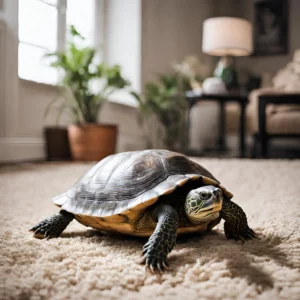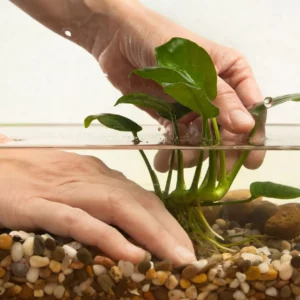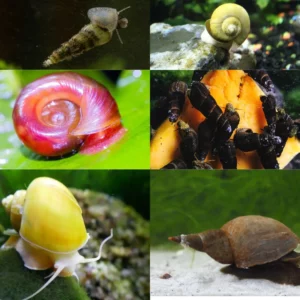While adding algae eaters to a turtle tank may not always be necessary, they play an important role in keeping your turtle’s habitat clean.
Algae eaters do a great job at:
- Eating algae and preventing its uncontrollable spreading
- Water filtration
- Simulating/mimicking your turtle’s natural habitat and encouraging natural behavior
- Keeping your pet company
But what is the best algae eater for a turtle tank?
I’ve listed some of the best algae eaters to help you find the best one for your turtle’s tank.
Let’s dive in!
Best Algae Eater for Turtle Tank
| South American Plecos |
| Butterfly Goodeid |
| Siamese Algae Eater |
| American Flag Fish |
| Otocinclus |
| Rosy Barbs |
| Flying Fox |
| Live-Bearer Fish (Mollies) |
Table of Contents
Butterfly Goodeid – Best Overall
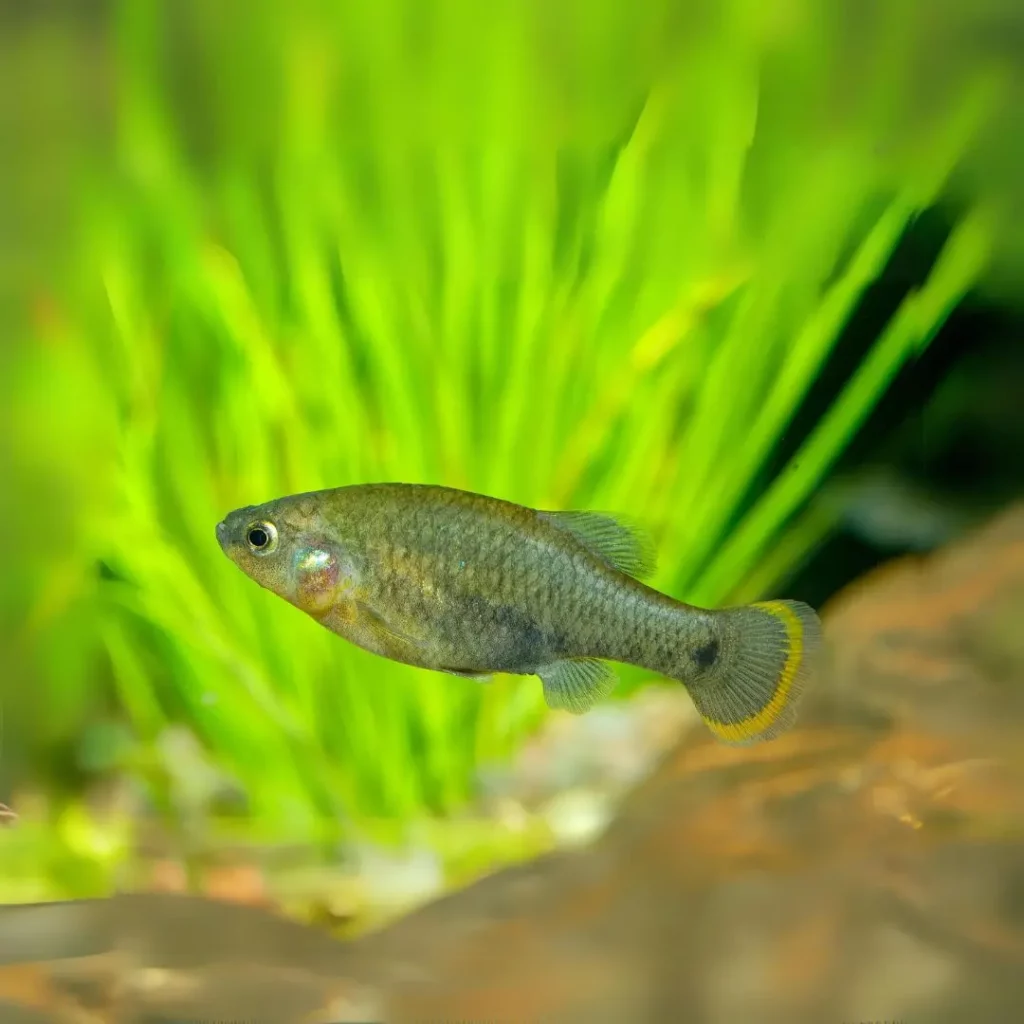
Butterfly Goodeid is a platy-sized fish famous for algae control capabilities but an incredibly hardy and quite rare species. Butterfly Goodeids eat hair algae, green spot algae, and even blue-green algae, making them the best algae eaters overall since only a few others can match their appetite.
However, some aquarists suggest that these little fellows can become aggressive toward other fish and softer plants, although it’s not confirmed – this is why they’re more fit for experienced turtle owners who don’t plan on adding more than one algae eater species.
| Characteristics | |
| Binomial name | Ameca splendens |
| Family | Goodeidae |
| Average lifespan | Three to five but females can live a year or two longer |
| Required temperature | 59~86°F/15~30°C |
| Required water pH | 7.0~8.0 |
South American Plecos
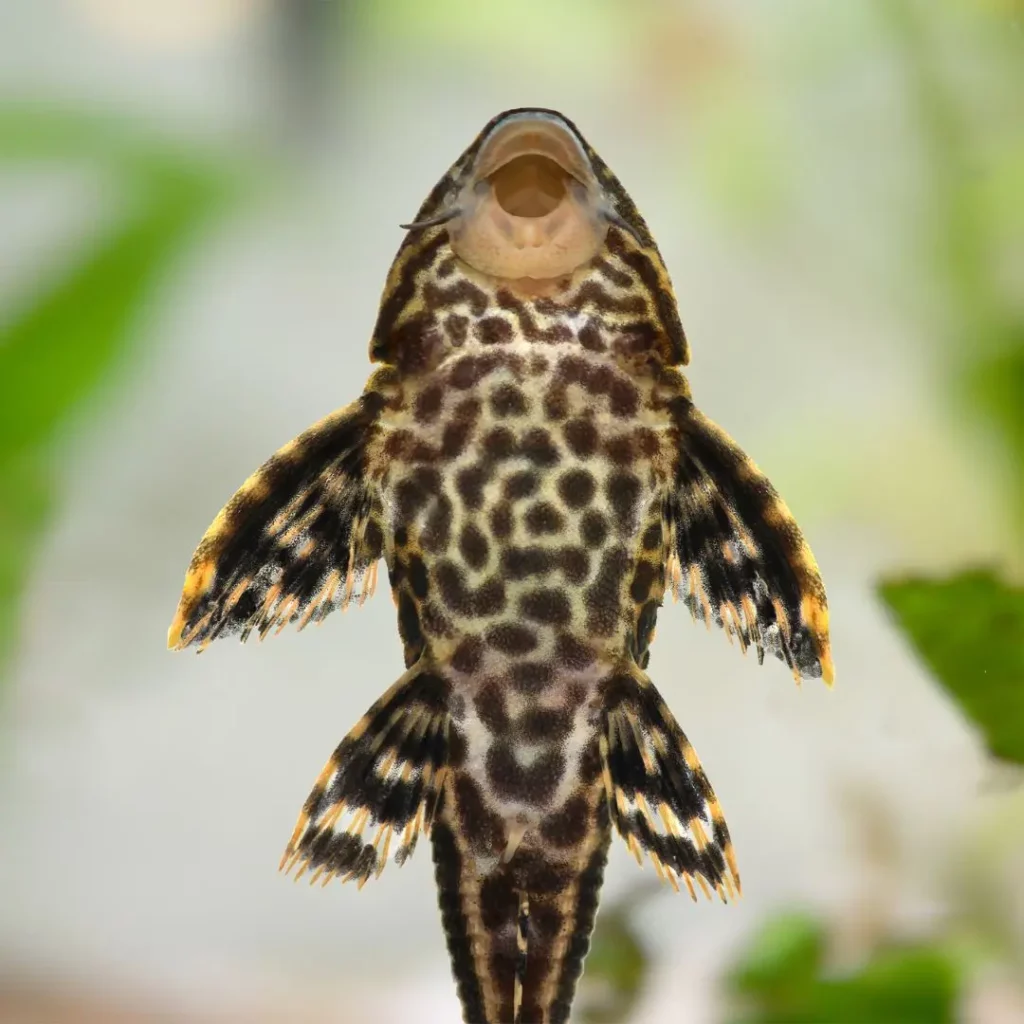
The South American pleco, also known as the Plecostomus, is a freshwater fish native to South America. These fish are incredibly resilient and can thrive in both freshwater and saltwater aquariums.
Plecos typically don’t bother pets like turtles as they’re naturally peaceful. If you have a turtle tank, plecos can make an excellent addition. They’re also a hardy species that can adapt to various conditions.
These fish will consume almost anything you provide in the tank, so there’s no need to be concerned about them eating your turtle’s food. They thrive on various foods, such as flaked fish filets, cichlid pellets, and cuttlefish bone meal, making them one of the lower-maintenance algae eaters.
The three most common species of algae-eating Plecos are:
- Common Pleco (Hypostomus plecostomus): The most frequently encountered type of pleco. It typically reaches about 4 inches and displays a slightly brown hue with darker spots or stripes. Additionally, it possesses a large head and prominent eyes.
- Clown Pleco: Relatively easy to breed and exhibits excellent parenting skills. This makes them an ideal choice for beginner freshwater turtle enthusiasts. They only grow about three to four inches/7.6 to 10.2 cm long.
- Bristlenose Pleco: Bristlenose Pleco is similar to the common pleco but has thorn-like whiskers growing from its nose. These whiskers are larger in males.
Unlike the common pleco, Bristlenose Plecos usually grow up to five to six inches/12.7~15,2 cm in size, but they’re generally heavier.
Note: Due to their size, you should never keep adult Bristlenose Plecos in tanks smaller than 20 gallons.
Also, be aware of males as they’re territorial and will guard their eggs constantly, regardless of your pet’s intent. Although they’re not that common in pet stores like some other algae eaters.
| Characteristics | |
| Binomial name | Plecostomus |
| Family | Loricariidae |
| Average lifespan | About ten years |
| Required temperature | About 80°F/26.7°C |
| Required water pH | 7.0~8.0 |
Siamese Algae Eaters
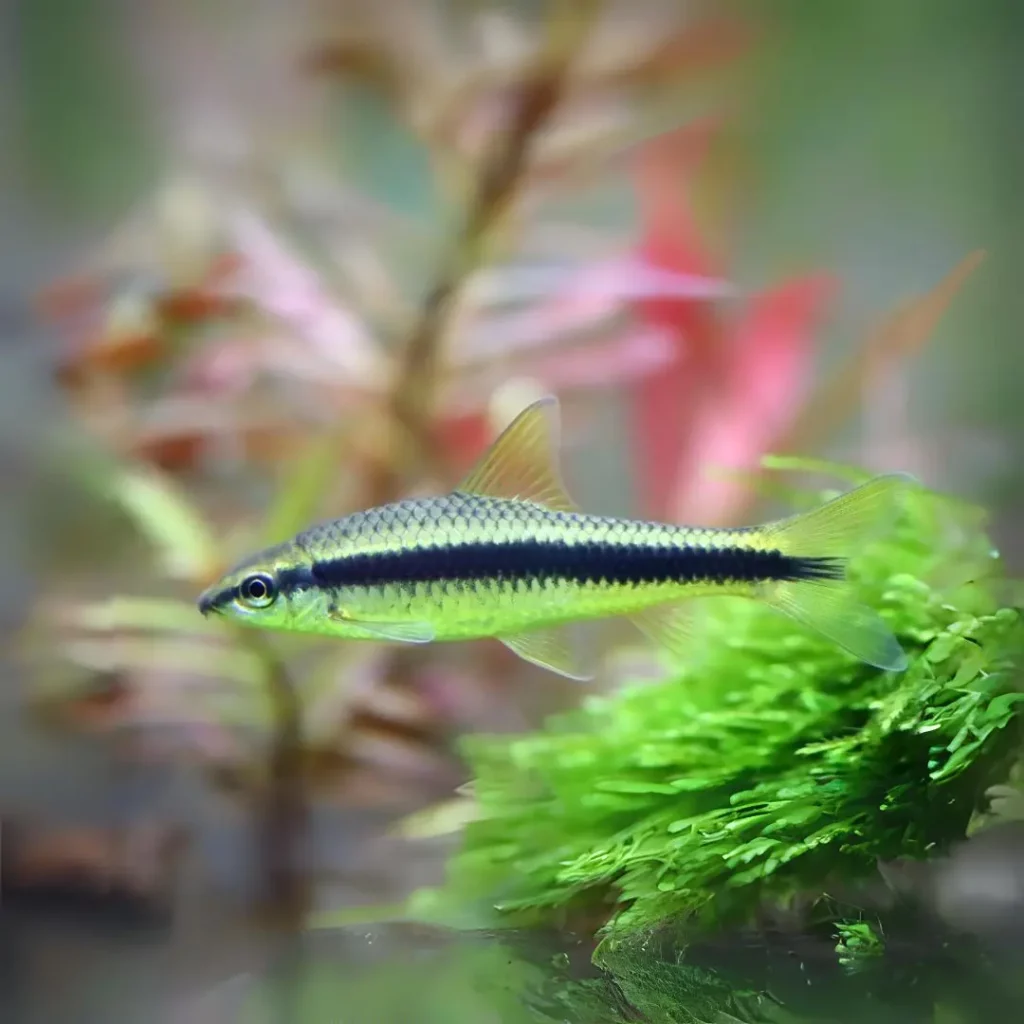
This fish is a slender, grayish-brown species with a unique black stripe running horizontally across its body.
It can reach a maximum length of about six inches/15.2 cm within a couple of years under optimal living conditions. However, it typically grows slower and may not always reach that size in captivity. Adult females are often slightly plumper than males, with no other known sexual differences.
Their fins are either transparent or slightly milky, lacking a yellow or reddish sheen. The fish possesses a pair of thin, forward-pointing barbels, which may be pressed against the cheeks while swimming or resting.
It’s a lively and swift swimmer, thriving in groups but adaptable to living alone or in pairs. It has impressive jumping abilities, and you should never leave the tank without a cover to prevent any potential escapes.
They’re noticeably more active and love to engage in playful chasing without causing harm to each other.
These algae eaters are among the longest-living species you can get, often living for an entire decade – a great choice if you don’t plan on adding other algae eaters or expanding their group.
| Characteristics | |
| Binomial name | Crossocheilus oblongus |
| Family | Cyprinidae |
| Average lifespan | More than ten year |
| Required temperature | 75~80°F/23.9~26.7°C |
| Required water pH | 6.5~7.5 |
American Flag Fish
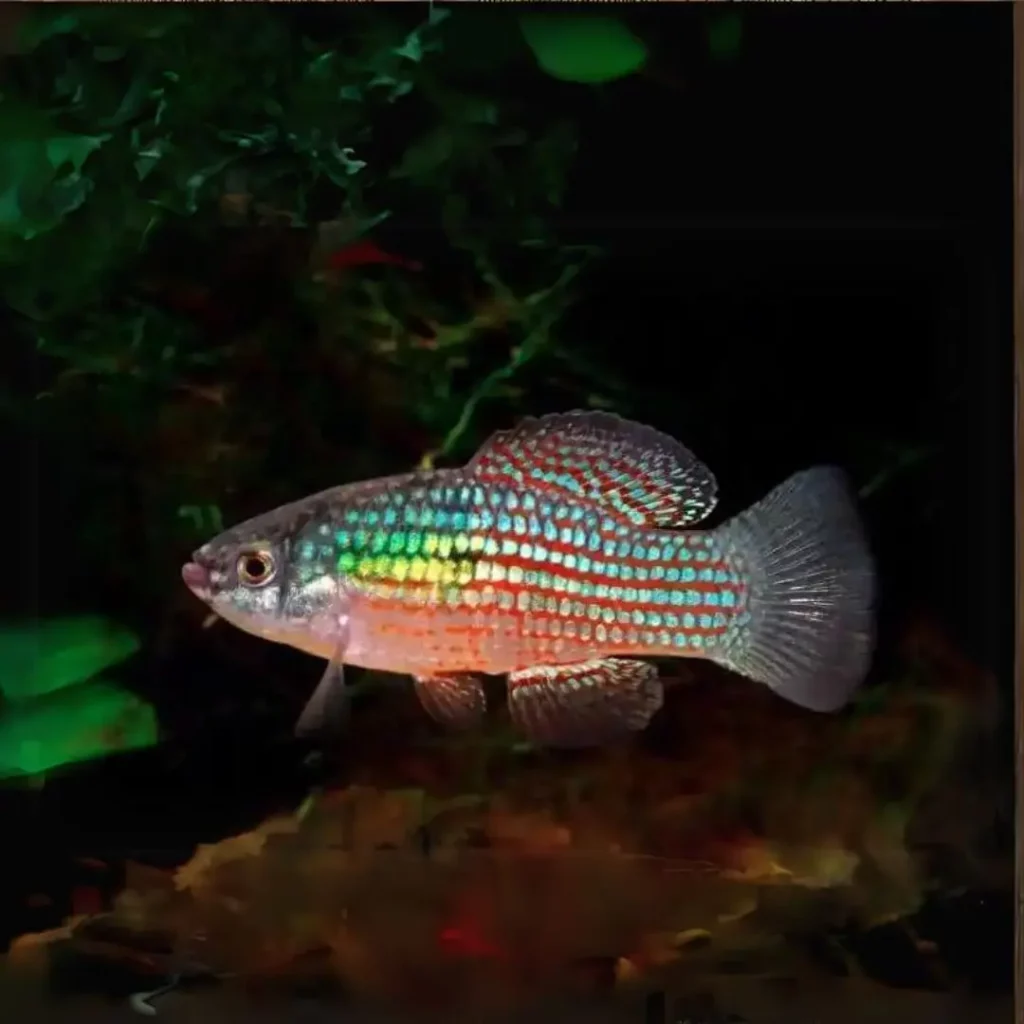
American Flag fish is a U.S. native from Florida, hardy and renowned for eating filamentous (green hairy) algae. Males get up to three inches/7.6 cm, and females are usually smaller (approximately less than an inch/2.5 cm).
This particular fish is a killfish that’s gaining popularity. The males have a beautiful coloration similar to the American Flag, giving them the appearance of small jewel cichlids or slightly elongated sunfish. As for females, they have less colorful patterns and are a bit rounder.
They are excellent at cleaning up filamentous algae, including leaves on plants, but they do not have sucker mouths, so do not expect them to completely remove the green film from glass surfaces like a vacuum cleaner.
| Characteristics | |
| Binomial name | Jordanella floridae |
| Family | Cyprinodontidae |
| Average lifespan | Two to three years |
| Required temperature | About 75°F/23.9°C |
| Required water pH | 6.5~8.0 |
Octoclincus
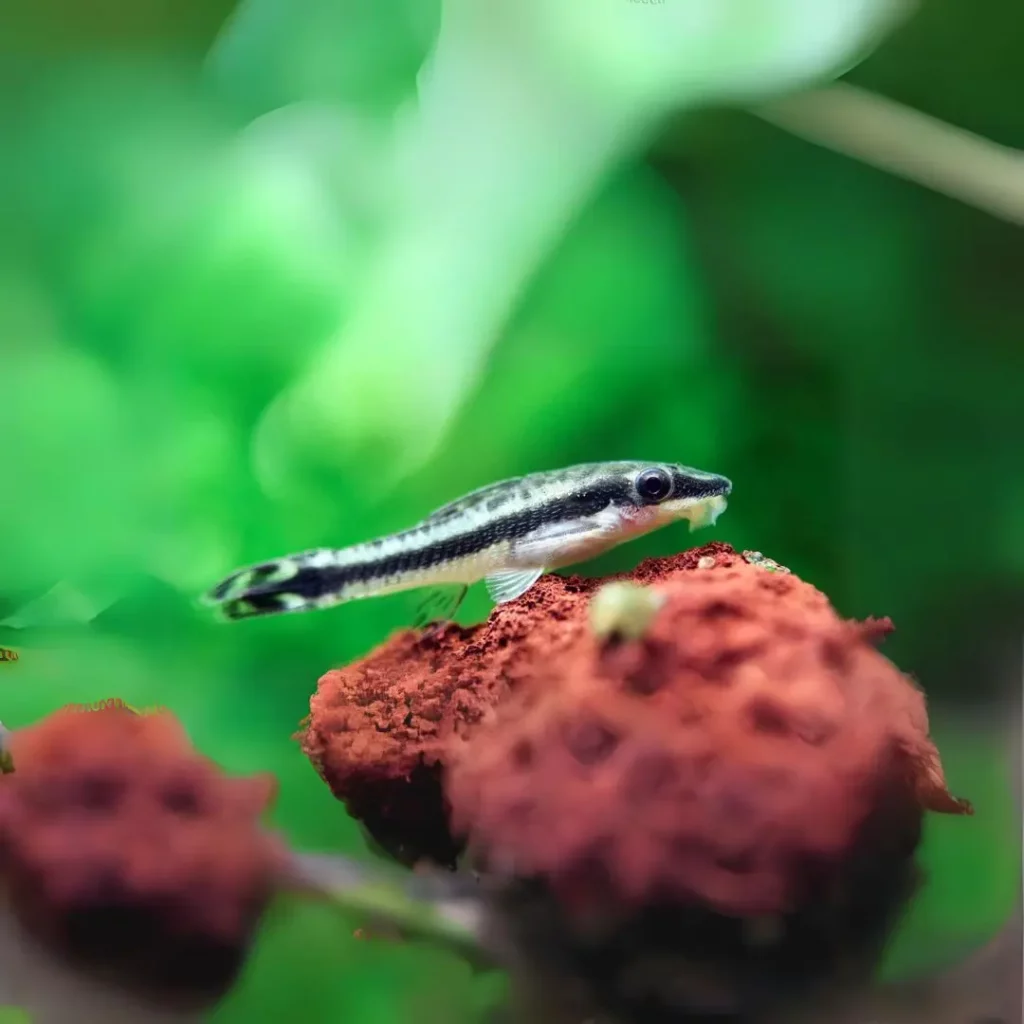
Otocinclus is another South American type of catfish but much smaller and less resilient. They’re incredibly sensitive to the living environment and can die shorter after purchase, but with adequate conditions, they could become long-term companions.
Otocinclus is one of the best algae eaters for turtle tanks and is small enough to clean algae off small surfaces like leaves and branches that a large pleco can’t work on.
However, they’re not a good choice for pet turtles who are mostly carnivorous and are used to eating smaller fish. In fact, most turtles eat protein-rich food (small fish, shrimps, insects, snails, etc). but they may survive with more fish in large tanks with lots of space and cover.
| Characteristics | |
| Binomial name | Otocinclus |
| Family | Loricariidae |
| Average lifespan | Three to five years |
| Required temperature | 75~80°F/23.9~26.7°C |
| Required water pH | 6.5~7.0 |
Rosy Barbs
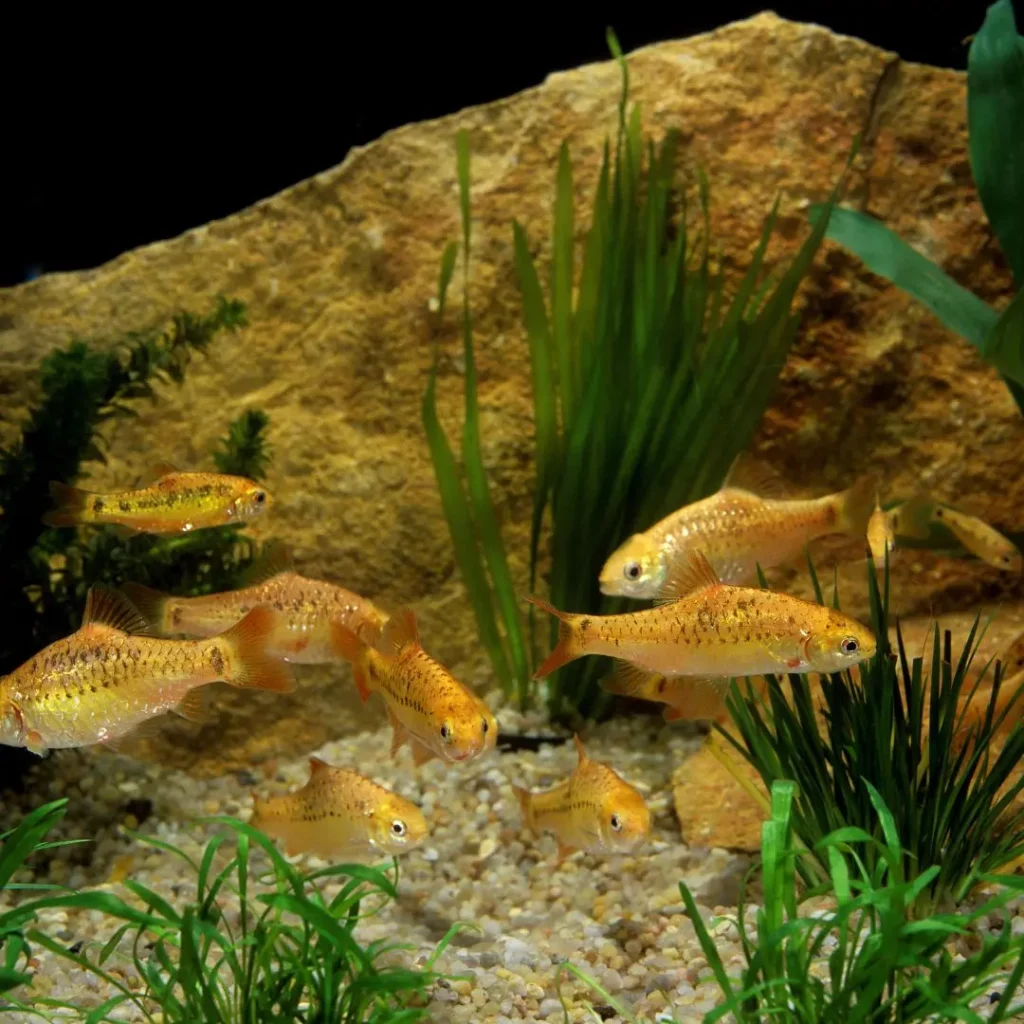
A Rosy Barb is a beautiful, medium-sized fish from India. They can often reach about six inches/ 15,2 cm in length, but in captive tanks, they typically don’t grow more than about three inches/7.6 cm.
Males are more richly colored and stay that way, although some aquarists believe they can change colors per season. Due to sexual dimorphism, you can keep one gender and avoid uncontrolled breeding. These algae eaters are vigorous, active, and fun to watch but will attack and kill smaller shrimps (for example, the Ghost shrimp).
They come with that ‘tropical fish’ appearance and make an excellent choice if you want to add a more unique look to your turtle tank.
| Characteristics | |
| Binomial name | Pethia conchonius |
| Family | Cyprinidae |
| Average lifespan | Up to five years |
| Required temperature | 65~70°F/18.3~21.1°C |
| Required water pH | About 7.0 |
Flying Fox
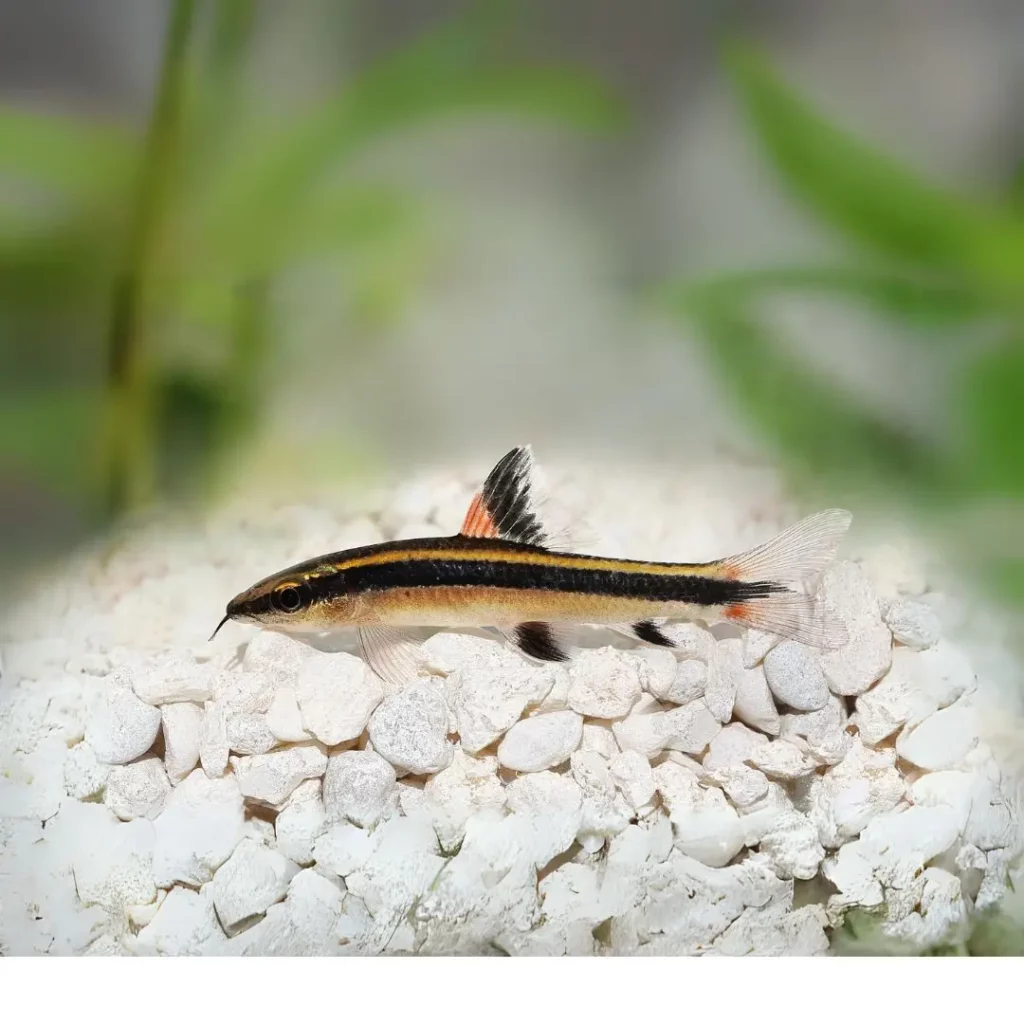
The appearance of a Flying Fox fish is much like of a Siamese algae eater except that their top part of the body (horizontal stripe) is much darker in color, broader, and goes through the tail fin.
They also have a narrow golden stripe over the black one. Their dorsal, anal, and pelvic fins have indistinctive dark parts and white tips. Flying Foxes have two pairs of barbels; their maximum length is about six inches/15.2 cm. However, there are no sexual differences between males and females.
Their behavior is also similar to Siamese algae eaters – although they’re more peaceful in general, most of the males are quite aggressive towards their kind.
However, they’re one of the fastest species on this list so they can be quite evasive if threatened by your turtle.
| Characteristics | |
| Binomial name | Epalzeorhynchos kalopterus |
| Family | Cyprinidae |
| Average lifespan | Up to ten years |
| Required temperature | 75~80°F/23.9~26.7°C |
| Required water pH | 6.5~7.5 |
Live-Bearer Fish (Mollies)
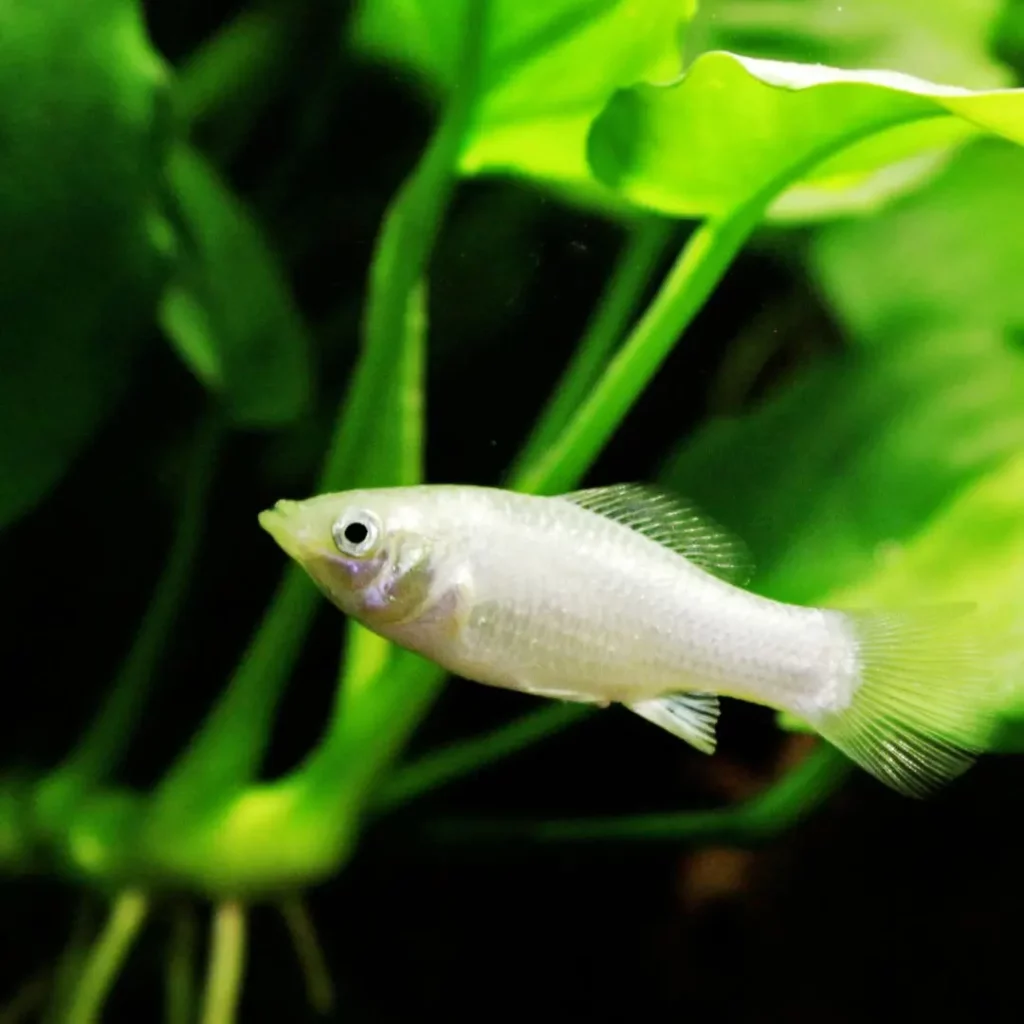
Some Live-Bearer Fish can also be a decent choice for starters. Many commercially available tropical fish like guppies, swordtails, and mollies will eat hair algae – though mollies tend to be the most common and effective for algae control.
Mollies prefer brackish water making them perfect for Diamond-back Terrapin owners who maintain brackish tanks.
It’s important to note that live bearers can reproduce rapidly and potentially overcrowd the tank. Some species, such as guppies, may be difficult for most types of pet turtles to catch, so occasionally using a dip-net to remove and eliminate them can help manage their overpopulation.
However, relying solely on them for controlling hair algae is not recommended, especially cleaning green parts from surfaces like glass or driftwood is not recommended.
| Characteristics | |
| Binomial name | Poecilia sphenops (Molly) |
| Family | Poeciliidae |
| Average lifespan | Three to five years |
| Required temperature | 75~80°F/23.9~26.7°C |
| Required water pH | 7.5~8.5 |
Other (Alternative) Types of Algae Eaters
A lot of new pet turtle parents think of algae eaters as fish. Although aquarium fish are the most popular type of algae eaters, we shouldn’t forget about snails and shrimps – although smaller and slower than fish, they can make an excellent addition.
Algae Eater Snails
The most common species are the Apple snail and the Mystery snail (which is extremely similar to the Apple snail species). Some species like Apple snails or Giant Pond snails can get incredibly larger than others (a bit larger than a golf ball) whereas mystery snails stay smaller.
Another good choice would be a Ramshorn snail (not to be mistaken for the Red Ramshorn snail, a different genus; the Columbian is known for eating live plants, whereas the smaller ramshorn species don’t) but they tend to overpopulate quickly so they’re not recommended for beginners.
Overall, snails for turtle tanks eat some algae but don’t have the reputation Plecos and Otocinclus do for cleaning the tank. Some munch on plants, too.
On the other hand, they munch on plants unlike most fish, and are also great companions for turtles. They’re an interesting addition to the tank, but you shouldn’t solely rely on them for primary algae control.
Algae Eater Shrimps
Shrimps can be of great assistance when it comes to algae maintenance in your turtle’s habitat. But it’s important to note that shrimps, due to their small size, are often a snack for the majority of turtles – not the best algae eater to start with or primarily rely on.
Most Shrimps love eating algae, but the best-known species are Amano shrimp who are incredibly fast at it. Ghost shrimp are typically easier to find and less expensive compared to Amanos.
Similarly to snails, using shrimps as the main algae control measure is not cost-effective for most tanks.
So try to think of them as extra help or companions to your turtles, fish, and snails.
You can find Chinese Algae eaters in a few YouTube vids and a few Google results, but these are much more aggressive and fight a lot, not just with each other but sometimes can try to attack smaller turtles, so I didn’t want to list them
The Common Risks of Having Algae In Your Turtle Tank

Although it’s fine to have a few algae in some spots of your turtle tank, an overgrowth can quickly become an issue. Not only is it aesthetically unappealing, but it can be really difficult to clean it.
However, on a more serious note, it can turn your turtle’s habitat into an unhealthy environment.
Here are some of the reasons you shouldn’t take algae lightly:
Shell (and Overall Health) Problems
Algae buildup poses shell health hazards by infiltrating a turtle’s partially shed scutes, leading to a condition known as shell rot. This can conceal injuries and infections, complicating the early detection of health issues.
Algae commonly grow on the shell’s exterior, and you can remove it by regularly brushing it with disinfectant cleaners. This may indicate a dirty tank and infrequent water changes.
To maintain a clean tank, use a filter and remember to replace it regularly. If the algae growth becomes excessive and penetrates the shell surface, it is advisable to seek medical assistance from a veterinarian.
UVB Insufficiency
Algae acts as a UV-blocking party crasher, hindering turtles from receiving essential UV rays vital for their health. This interference can be likened to placing a thick blanket over a sunbather, impeding the absorption of crucial sunlight.
Poor Water Quality
Algae blooms can adversely affect water quality, creating an environment where turtles struggle to breathe and thrive. This scenario is comparable to living in a room that is excessively dusty and stuffy, hindering the turtle’s overall well-being.
Introducing Algae Eaters To Your Turtle Tank
Now that you know the best options for algae eaters, you may wonder whether they can live simultaneously with your shelled companions and how to keep them safe in your turtle tank.
Algae eaters can coexist with turtles, but providing them with a spacious tank of at least 75 gallons is important. The tank should be maintained at a suitable temperature between 80 and 82 degrees Fahrenheit, with the heater set to 78 degrees and the air temperature around 70 degrees. The pH level should be maintained between 6.5 and 7.5.
To ensure a suitable environment for your turtle, it is important to provide hiding places and open swimming spaces.
Algae Eaters prefer to rest and hide under rocks or plants, where they can feel secure from predators. Additionally, it is recommended to have a slow-running filter to avoid disrupting the turtle’s natural habitat.
Pro tip: Before introducing new algae eaters to the tank, quarantine them in a separate tank for 2-4 weeks to ensure they’re healthy and free of parasites or diseases that could harm your turtles.
Keeping Your Algae Eaters for Turtle Tank Safe and Sound
Before you decide which algae eater you want to add to your turtle’s habitat, you should know how to keep them alive (as they’re quite sensitive creatures, especially in captivity).
To help you out, here are some important guidelines you should follow:
- Compatibility: Consider what species would thrive along your turtle. For instance, some fish may be too small for your turtle tank and others too big. Also, Some algae eaters won’t clean small surfaces on branches, leaves, in corners while others will.
- Provide a spacious and well-planted tank: A larger tank with ample space for turtles and algae eaters will reduce stress and territorial behavior (aggression). Adding live plants creates hiding spots for algae eaters and absorbs excess nutrients, reducing algae growth overall.
- Enrich their diet: Complement the algae eaters’ natural diet with algae wafers or sinking pellets to ensure they get enough nutrients.
Some of the healthiest, quality sinking pellets you can buy:
- API TROPICAL PELLETS Sinking Pellets Fish Food
- Aqueon Cichlid Slow Sinking Fish Food Pellets
- Hikari Sinking Fish Food
Wafers to provide extra nutrients for your hard-working algae cleaners:
- Maintain Excellent Water Quality: Regular water changes (a couple times weekly) remove waste and excess nutrients that fuel algae growth. Be sure also to use a high-quality filter to keep the water even cleaner.
Pro tip: Test the water regularly for ammonia, nitrite, and nitrate to ensure it’s safe for turtles and algae eaters. You can do this via ammonia test strips.
Here are a few quality ones to check out:
- Tetra EasyStrips Complete Kit
- EASYTEST [50 Strip] Ammonia Test Kit
- API AMMONIA 130-Test Freshwater and Saltwater
A word of advice: Not only are these some of the best-quality stripes but you can get plenty of them for a fair price and there are versions suitable for both types of water (freshwater and saltwater).
- Create safe areas: Provide hiding spots for algae eaters, such as caves, driftwood, or dense plants. This gives them a place to retreat if they feel threatened by the turtles.
- Supervise: Observe any interactions between turtles and algae eaters closely. If turtles become aggressive or try to eat the algae eaters, you may need to separate them or choose a different species of algae eater.
My Senior Paws is a participant in the Amazon Services LLC Associates Program, an affiliate advertising program designed to provide a means for sites to earn advertising fees by advertising and linking to Amazon.com. We also participate in other affiliate programs which compensate us for referring traffic.


